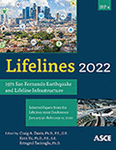Overview of a Framework to Engineer Infrastructure Resilience through Assessment, Management, and Governance
Publication: Lifelines 2022
ABSTRACT
Infrastructure system resilience prior to or following disruptions due to natural or technological hazards is intimately linked with and supports community resilience. This paper presents a framework, consisting of eight key elements, connecting processes and tools for assessment, management and governance related decisions, and the community outcomes. It recognizes infrastructure as interdependent socio-technical systems capable of achieving resilience through optimized flow and provision of services to users that satisfy community-level objectives by reducing social and economic losses while enhancing community wellbeing. In this paper, an overview of the framework is provided.
Get full access to this article
View all available purchase options and get full access to this chapter.
REFERENCES
Ayyub, B. M. (2001). Uncertainties in expert-opinion elicitation for risk studies. In Risk-Based Decision making in Water Resources IX (pp. 103-121).
Ayyub, B. M. (2002). Elicitation of Expert Opinions for Uncertainty and Risks, CRC Press, FL.
Ayyub, B. M. (2014). Systems resilience for multihazard environments: Definition, metrics, and valuation for decision making. Risk Analysis J., 34(2):340-55, DOI: https://doi.org/10.1111/risa.12093, 2014 (Epub 2013 Jul 22).
Ayyub, B. M. (2015). “Practical Resilience Metrics for Planning, Design, and Decision Making,” ASCE-ASME J. Risk Uncertainty Eng. Syst., Part A: Civil Eng., DOI: https://doi.org/10.1061/AJRUA6.0000826.
Bruneau, M., Chang, S. E., Eguchi, R. T., Lee, G. C., O’Rourke, T. D., Reinhorn, A. M., Shinozuka, M., Tierney, K., Wallace, W. A., and Winterfeldt, D. (2003). “A framework to quantitatively assess and enhance the seismic resilience of communities.” Earthquake Spectra 19, 733–752.
Cimellaro, G. P., Reinhorn, A. M., and Bruneau, M. (2010). “Seismic resilience of a hospital system.” Struct. Infrastruct. Eng., 6(1–2), 127–144. Civil Contingencies Secretariat of the Cabinet Office, London. (2003).
Croope, S., and McNeil, S. (2011). “Improving Resilience of Critical Infrastructure Systems Post-Disaster for Recovery and Mitigation”, Transportation Research Record No 2234, pp3-13.
Cutter, S. L., Barnes, L., Berry, M., Burton, C., Evens, E., Tate, E., and Webb, J. (2008). “A Place-Based Model for Understanding Community Resilience to Natural Disasters,” Global Environmental Change, Elsevier, vol 18, pp 598-606.
Davis, C. A. (2013). “Quantifying Post-Earthquake Potable Water System Services,” 6th China-Japan-US Trilateral Symposium Lifeline Earthquake Engineering, Chengdu, China, May 28-June 1, 2013, TCLEE Monograph No. 38, ASCE, Reston VA, pp. 19-26.
Davis, C. A. (2014). Water system service categories, post-earthquake interaction, and restoration strategies. Earthquake Spectra, 30(4), 1487-1509.
Davis, C. A. (2021). “Understanding Functionality and Operability for Infrastructure System Resilience,” ASCE Natural Hazards Review, 22(1), https://doi.org/10.1061/(ASCE)NH.1527-6996.0000431.
Davis, C. A., Mostafavi, A., and Wang, H. (2018). Establishing Characteristics to Operationalize Resilience for Lifeline Systems, Natural Hazards Review, 19(4).
Davis, C., Ayyub, B., McNeil, S., Kobayashi, K., Tatano, H., Onishi, M., Takahashi, Y., Honda, R., Koike, T., and van de Lindt, J. (2021). “Infrastructure Resilience: A Framework for Assessment, Management and Governance,” Proc. 4th GADRI meeting, March 2019, Kyoto, JP, Springer.
Davis, C., Ayyub, B., McNeil, S., Kobayashi, K., Tatano, H., Onishi, M., Takahashi, Y., Honda, R., van de Lindt, J., and Koike, T. (2022). A Framework to Engineer Infrastructure Resilience Through Assessment, Management and Governance, ASCE Infrastructure Resilience Publication, submitted.
Duke, C. M., and Moran, D. F. (1975). “Guidelines for Evolution of Lifeline Earthquake Engineering.” In Proc., US National Conf. on Earthquake Engineering, 367–376. Oakland, CA: Earthquake Engineering Research Institute.
Gilbert, S. W., Butry, D. T., Helgeson, J. F., and Chapman, R. E. (2015). Community Resilience Economic Decision Guide for Buildings and Infrastructure Systems, NIST SP 1197, National Institute of Standards and Technology, Gaithersburg, MD. https://doi.org/10.6028/NIST.SP.1197.
Gilbert, S., and Ayyub, B. M. (2016). Models for the Economics of Resilience. ASCE-ASME J. Risk Uncertainty Eng. Syst., Part A: Civil Eng., DOI: https://doi.org/10.1061/AJRUA6.0000867.
Kusel, J., and Fortmann, L. P. (1991). What is community well-being? In J. Kusel and L. Fortman (eds.). Well-being in forest-dependent communities (Volume I). Pp.1-45/ Forest and Rangeland Resources Assessment Program and California Department of Forestry and Fire Protection, Berkley, California.
Lexico.com. (2020). Definitions in English. Powered by Oxford, first accessed April 2019.
NIST. (2015). “Community resilience planning guide for buildings and infrastructure systems.”, https://doi.org/10.6028/NIST.SP.1190v1.
Rose, A. (2004). “Economic Principles, Issues, and Research Priorities in Hazard Loss Estimation.” In: Okuyama Y., Chang S.E. (eds) Modeling Spatial and Economic Impacts of Disasters. Advances in Spatial Science. Springer, Berlin, Heidelberg.
Rose, A. (2009). “Economic Resilience to Disasters,”. http://research.create.usc.edu/published_papers/75.
Rose, A. (2016). “Benefit-cost analysis of economic resilience actions,” Oxford Research Encyclopedia of Natural Hazard Science, Oxford university Press, USA.
Tierney, K., and Bruneau, M. (2007). “Conceptualized and measuring resilience.” TR News 250, 14–17, 〈http://onlinepubs.trb.org/onlinepubs/trnews/trnews250_p14-17.pdf〉 (Apr. 8, 2015).
What Works Wellbeing. (2017). “What is Community Wellbeing? Conceptual Review,” 67 p., whatworkswellbeing.org, accessed April 22, 2019.
Wiseman, J., and Brasher, K. (2008). “Community Wellbeing in an Unwell World: Trends, Challenges, and Possibilities,” Journal of Public Health Policy, 29, 353–366 r 2008 Palgrave Macmillan Ltd 0197-5897/08, www.palgrave-journals.com/jphp.
Information & Authors
Information
Published In
History
Published online: Nov 16, 2022
Authors
Metrics & Citations
Metrics
Citations
Download citation
If you have the appropriate software installed, you can download article citation data to the citation manager of your choice. Simply select your manager software from the list below and click Download.
